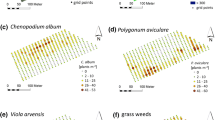Abstract
Though the knowledge that certain plant species prefer certain habitats and can therefore be used as indicators is a very familiar one to people of so-called ‘primitive’ cultures, it surprisingly found scientific evaluation rather late — mainly in this century. Practical applications in forestry or prospecting for water or minerals have come into use, but weeds as indicators have found very little attention in agriculture. One reason is certainly the negative attitude towards weeds leaving no room for the idea that the occurrence of weeds might be valuably utilized in one way or the other. Another reason is that agriculturists prefer numerical data to complex biological statements because they are often not aware of the sometimes rather factious exactness of the first.
Access this chapter
Tax calculation will be finalised at checkout
Purchases are for personal use only
Preview
Unable to display preview. Download preview PDF.
Similar content being viewed by others
References
Bannink, J.F., H.N. Leys and I.S. Zonneveld (1974) Akkeronkruidvegetatie als indicator van het milieu, in het bijzonder de bodemgesteldheid (Weeds as environmental indicators, especially for soil conditions). Bodemkundige studies 11 ( Stichting v. Bodemkart. ), Wageningen ). 87 pp.
Barralis, G., Monneron, J. De, and J. Chrétien (1971). Research on the relationship between the weed flora and the soil of the Cote d’Or department (French). In: Procés-verbal de l’Académie d’Agriculture de France. (Académie d’Agriculture). 1335–1344 (after Weed Abstracts).
Borg, P. (1964). Über die Beziehungen der Ackerunkräuter zu einigen bodenökologischen Faktoren in der Landgemeinde Helsinki. Ann. Bot. Fenn. 1: 146–160.
Buchanan, G.A., C.S. Hoveland and M.C. Harris (1973). Response of Weeds to Soil pH. Weed Science 23: 473–477.
Duke, J.A. (1976). Perennial weeds as indicators of annual climatic parameters. Agric. Meteor. 16: 291–294.
Ellenberg, H. (1950). Unkrautgesellschaften als Zeiger für Klima und Boden. Landw.Pflsoz. I. Ulmer, Stuttgart.
Ellenberg, H. (1951). Landwirtschaftliche Standortskartierung auf pflanzengemäßer Grundlage. Z. Pflanzenern., Düng., Bodenkd. 53: 204–224.
Ellenberg, H. (1952). Physiologisches und ökologisches Verhalten derselben Pflanzenarten. Ber. Dtsch. Bot. Ges. 65: 350–361.
Ellenberg, H. (1958). Bodenreaktion (einschließlich Kalkfrage). In: Handbuch der Pflanzenphysiologie IV: 638–708. E. Ruh-land (ed.), Springer Wien-New York. pp. 638–708.
Ellenberg, H. and M.-L. Snoy (1957). Physiologisches und ökologisches Verhalten von Ackerunkräutern gegenüber der Bodenfeuchtigkeit. Mitt. Staatsinst. f. Allg. Bot. Hamb. 11: 47–87.
Hilbig, W. (1967). Ein Vergleich bodenkundlicher und vegetationskundlicher Kartierung landwirtschaftlicher Nutzflächen in Bereich des mittelsächsischen Lößhügellandes. Arch. Naturschutz u. Landschaftsforsch. 7: 281–314.
Hilbig, W., E.-G. Mahn, R. Schubert and E.-M. Wiedenroth (1962). Die ökologisch-soziologischen Artengruppen der Ackerunkrautvegetation Mitteldeutschlands. Bot. Jahrb. 81: 416–449.
Holzner, W. (1971). Niederösterreichs Ackervegetation als Umweltzeiger. Die Bodenkultur (Wien) 22: 397–414.
Hoveland, C.S., G.A. Buchanan and M.C. Harris (1976) Response of Weeds to Soil Phosphorus and Potassium. Weed Sci. 24: 194–201.
Kinzel, H. (1969). Ansätze zu einer vergleichenden Physiologie des Mineralstoffwechsels und ihre ökologischen Konsequenzen. Ber. Dtsch Bot. Ges. 82: 143–158.
Kinzel, H. (1971a). Typen des Mineralstoffwechsels bei den höheren Pflanzen. Osten. Bot. Z. 119: 475–495.
Kinzel, H. (1971b) Biochemische Ökologie - Ergebnisse und Aufgaben. Ber. Dtsch. Bot. Ges. 84: 381–403.
Klemm, G. (1976). Zur Beziehung zwischen Wasserfaktor und Pflanzengesellschaften eines grundwassernahen Talsandgebietes ( Unterspreewald-Randgebiet ). Limnologica (Berlin) 11: 125–160.
Koch, F. (1955). Die Auswirkungen der anormalen Trockenheit des Sommers 1952 auf die Ackerunkrautgemeinschaften deutscher Dauerdüngungsversuche. Z. Pflanzenbau u. Pflanzenschutz 6: 32–40.
Kühn, F. (1975). Ackerunkrautvegetation und Bodenfeuchtigkeit. In: Vegetation und Substrat, H. Dierschke (ed.). J. Cramer Vaduz, 256–264.
Kutschera, L. (1966). Ackergesellschaften Kärntens als Grundlage standortgemäßer Acker-und Grünlandwirtschaft. Lumpenstein-Irdning (Austria).
Lutz, J.L. (1954). Häufigkeitskurven mittlerer Wasserzahlen von Hack-und Halmfruchtgesellschaften als Standortsindikatoren. Vegetatio 56: 83–87.
Montegut, J. (1979). Facteurs climatiques et developement des graminees envahissantes des cereales en France. In: Proc. EWRS Symp. `The Influence of different Factors on the Development and Control of Weeds’ Mainz pp. 49–56.
Numata, M. (1975). Research on Bio-Indicators in Japan. In: Studies in Urban Ecosystems, M. Numata (ed.), Tokyo.
Rehder, H. (1959). Über die Beziehungen der Ackerunkräuter zur Bodenart sowie zum Säuregrad, Phosporsäure-und Kaligehalt des Bodens im Raum um Hamburg. Abh. naturw. Ver. Hamburg, N.F., 3: 55–85.
Rehder, H. (1963). Einfluß des Phosphorsäure-und Kaligehaltes der Böden auf das Auftreten von Unkräutern. Z. Pflanzenkrankh. (Pflanzenpath.) u. Pflanzenschutz, Sonderh. II: 29–34.
Reuß, H.-U and G. Bachthaler (1979). Einfluß von Standort und Produktionstechnik auf die lokale Unkrautflora am Beispiel unterschiedlicher Fruchtfolgen. In: Proc. EWRS Symp. The Influencechwr(133) (see Montegut), Mainz. pp. 57–64.
Sugawara, S. (1975). Studies on the shifts in weed vegetation in the maturation process of farms. 2. Soil acidity as basis of indication of weed population. Weed Res. ( Japan ) 20: 23–29.
Sugawara, S. (1978). chwr(133) 6. Estimation of the degree of field maturation of volcanic ash soil zones by the use of the weed population. Bull. Fac. Agric. Niigata Univ. 30, 23–30.
Walther, K. (1953). Ernteerträge und Unkrautgesellschaften. Mitt. Flor.-soz. Arbgem. N.F. ( Stolzenau ) 4.
Walther, K. (1966). Ertragsbestimmungen von Feldfrüchten in verschiedenen Ackergesellschaften. In: Anthropogene Vegetation, R. Tüxen (ed.), Junk, Den Haag. pp. 103–105.
Weller, F. (1978). Stand der agrarökologischen Kartierung in Baden-Württemberg. Beih. Veröff. Naturschutz Landschaftspflege Bad.-Württ. 11: 215–230.
Editor information
Editors and Affiliations
Rights and permissions
Copyright information
© 1982 Springer Science+Business Media Dordrecht
About this chapter
Cite this chapter
Holzner, W. (1982). Weeds as indicators. In: Holzner, W., Numata, M. (eds) Biology and ecology of weeds. Geobotany, vol 2. Springer, Dordrecht. https://doi.org/10.1007/978-94-017-0916-3_17
Download citation
DOI: https://doi.org/10.1007/978-94-017-0916-3_17
Publisher Name: Springer, Dordrecht
Print ISBN: 978-90-481-8519-1
Online ISBN: 978-94-017-0916-3
eBook Packages: Springer Book Archive




